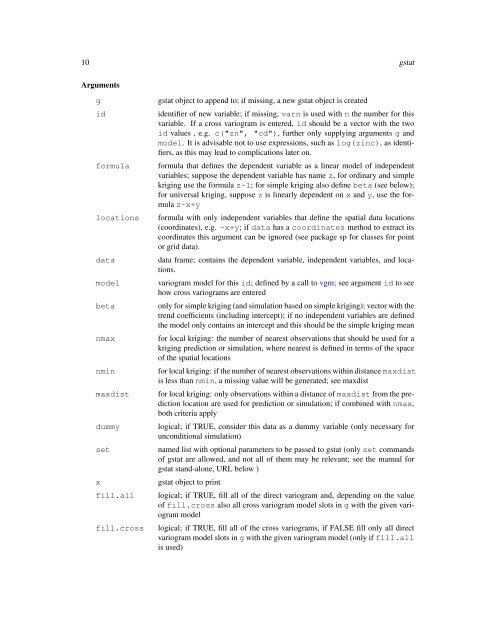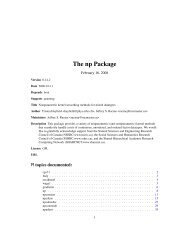The gstat Package - NexTag Supports Open Source Initiatives
The gstat Package - NexTag Supports Open Source Initiatives
The gstat Package - NexTag Supports Open Source Initiatives
Create successful ePaper yourself
Turn your PDF publications into a flip-book with our unique Google optimized e-Paper software.
10 <strong>gstat</strong>Argumentsgidformulalocationsdatamodelbetanmaxnminmaxdistdummysetxfill.allfill.cross<strong>gstat</strong> object to append to; if missing, a new <strong>gstat</strong> object is createdidentifier of new variable; if missing, varn is used with n the number for thisvariable. If a cross variogram is entered, id should be a vector with the twoid values , e.g. c("zn", "cd"), further only supplying arguments g andmodel. It is advisable not to use expressions, such as log(zinc), as identifiers,as this may lead to complications later on.formula that defines the dependent variable as a linear model of independentvariables; suppose the dependent variable has name z, for ordinary and simplekriging use the formula z~1; for simple kriging also define beta (see below);for universal kriging, suppose z is linearly dependent on x and y, use the formulaz~x+yformula with only independent variables that define the spatial data locations(coordinates), e.g. ~x+y; if data has a coordinates method to extract itscoordinates this argument can be ignored (see package sp for classes for pointor grid data).data frame; contains the dependent variable, independent variables, and locations.variogram model for this id; defined by a call to vgm; see argument id to seehow cross variograms are enteredonly for simple kriging (and simulation based on simple kriging); vector with thetrend coefficients (including intercept); if no independent variables are definedthe model only contains an intercept and this should be the simple kriging meanfor local kriging: the number of nearest observations that should be used for akriging prediction or simulation, where nearest is defined in terms of the spaceof the spatial locationsfor local kriging: if the number of nearest observations within distance maxdistis less than nmin, a missing value will be generated; see maxdistfor local kriging: only observations within a distance of maxdist from the predictionlocation are used for prediction or simulation; if combined with nmax,both criteria applylogical; if TRUE, consider this data as a dummy variable (only necessary forunconditional simulation)named list with optional parameters to be passed to <strong>gstat</strong> (only set commandsof <strong>gstat</strong> are allowed, and not all of them may be relevant; see the manual for<strong>gstat</strong> stand-alone, URL below )<strong>gstat</strong> object to printlogical; if TRUE, fill all of the direct variogram and, depending on the valueof fill.cross also all cross variogram model slots in g with the given variogrammodellogical; if TRUE, fill all of the cross variograms, if FALSE fill only all directvariogram model slots in g with the given variogram model (only if fill.allis used)
















